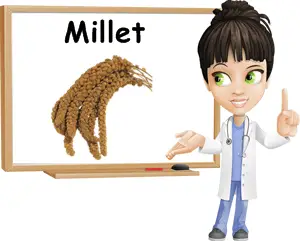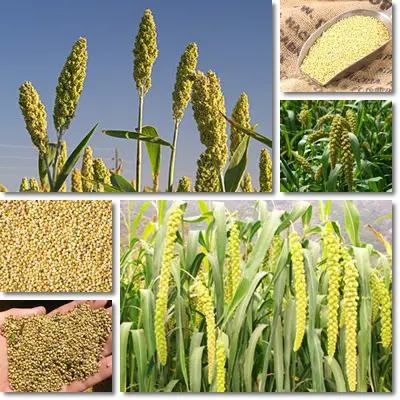In countries with an arid or semi-arid climate, millet is a staple crop of significant economic importance, taking the place of wheat and corn. Millet is a true grass or cereal, just like wheat, maize and rice, and a great source of essential nutrients.
It is rich in thiamine, riboflavin, niacin, pantothenic acid, vitamin B6 and folate, all of which support carbohydrate synthesis and contribute to the good functioning of our nervous system.
A good source of iron, magnesium, manganese, phosphorus and zinc, millet promotes bone and muscle health, supports the immune function, has benefits on mood and exhibits antioxidant activity.
Rich in fiber and low in fat, it is an excellent constipation remedy with cholesterol-lowering properties. More important, millet is gluten-free, making it a great option for anyone dealing with wheat sensitivity or wheat intolerance and celiac disease. Millet flour is a wonderful substitute for wheat flour and anyone looking to exclude gluten from their diet should consider it along with rice flour, brown rice flour, almond flour, corn flour or maize flour (used to make polenta), buckwheat flour or potato flour.

What does millet look like?
Millet is a tiny, round or slightly oval, pointy seed. It comes in a variety of colors, namely white, yellow, golden yellow, light grey, red-orange, brown, even purple-blue and dark grey. However, usually white and yellow millet is available on a large scale outside its areas of production. Nutritional differences between millet species are often insignificant, but raw millet is generally more nutritionally dense than cooked millet. Also, different grain colors indicate the presence of different antioxidant compounds with varying antioxidant activities.
What does millet taste like?
Millet is one of those foods that take after the main flavor in the dish it is put in. Its somewhat sweet, nutty taste quickly dissipates when cooked, making it ideal as a neutral base for meat or vegetable dishes. This West African cereal is ideal as a rice substitute in risotto, stuffed bell peppers, mushrooms or eggplant. It can be made into flatbread and pilaf or successfully paired with carrots, beans, potatoes, lentils, chickpeas and fish. You can even use millet flour for pizza or enjoy millet flakes for breakfast.
Types of millet
There are several major millet species which differ slightly in protein, fiber and nutrient content:
- Pearl millet (Pennisetum glaucum)
- Proso millet, white millet or broom corn millet (Panicum miliaceum)
- Foxtail millet (Setaria italica)
- Finger millet (Eleusine coracana)

Benefits and uses of Millet
What is millet good for?
The benefits of eating millet are a direct result of its nutritional profile. The most notable health effects stem from the good carbohydrate, protein, fiber, B vitamin content and smaller amounts of other essential nutrients. More important, the grain is gluten-free, adding to its health benefits.
Here are 8 reasons why you should include millet in your diet:
High protein content
Millet provides 11 g of protein/100 g of raw product and 3.5 g of protein/100 g of cooked seed, a considerable amount, making it a great staple for vegetarian and vegan diets or any diet lacking sufficient protein.
Rich source of fiber
With 8.5 g of fiber/100 g of raw seeds and 1.3 g of fiber/100 g of cooked seeds, millet is ideal for treating constipation naturally. Also, research suggests that a fiber-rich diet is protective of colon health. By promoting easy, effortless and regular bowel movements, fiber limits our colon’s exposure to waste and the toxins in it which is believed to reduce colon cancer risks (see more benefits of dietary fiber).
However, because it absorbs great amounts of water when boiled, fiber (and nutrient) ratio may drop significantly so you could turn to millet flour or millet flakes in order to increase your fiber intake. You can also counteract this dilution of nutrients as a result of cooking by pairing millet with various vegetables such as chickpeas, eggplants, tomatoes, zucchini and others.
Cholesterol-lowering properties
The good fiber content in millet prevents fats from being fully absorbed at the intestinal level which indirectly contributes to reducing LDL (bad) cholesterol and total cholesterol levels. Moreover, millet contains tocotrienol (a form of vitamin E) and phytosterols, two natural compounds known to further help lower blood cholesterol levels.
Good source of magnesium
With 19% of the RDA of magnesium per serving of raw grains, millet supports the activity of important muscles such as the heart. A good daily dietary intake of magnesium is said to reduce heart attack risks in people suffering from atherosclerosis and diabetes. Moreover, magnesium helps increase calcium absorption in bones and has been shown to alleviate allergy symptoms, improve mood swings and reduce migraine frequency.
100 g of cooked millet provides around 44 mg of magnesium, which is roughly 10% of the recommended daily intake of 420 mg. Including other magnesium rich foods such as spinach or cocoa, nuts and seeds in your diet could helps you meet your nutritional requirements.
Good content of phosphorus
The phosphorus in millet contributes to increasing bone mineral density, thus ensuring strong, healthy bones and teeth. Moreover, phosphorus-rich foods contribute to hormonal balance, help treat lack of appetite and prevent heartbeat abnormalities such as extrasystoles. 100 g of cooked millet provides around 8.5% of the recommended daily intake of phosphorus for an average adult. Other good sources of phosphorus include milk, fish and other seafood and meat in general.
Gluten free
Millet is gluten-free and can be safely consumed if you are suffering from Celiac disease, gluten sensitivity or intolerance. Other gluten-free cereals are amaranth, quinoa, buckwheat, white rice, brown rice, red rice and black rice and the flours made from them. Gluten free flours also include potato flour and nut flours as well as corn flour or maize flour, the original flour for making polenta (see benefits of polenta).
Good B vitamins content
Millet is a good source of thiamine (vitamin B1), riboflavin (vitamin B2), niacin (vitamin B3), pantothenic acid (vitamin B5), vitamin B6 and folate (vitamin B9). Folate is especially good during pregnancy because it helps prevent spinal cord defects called neural tube defects in newborn babies. This makes millet a good food option for pregnant women. Moreover, B vitamins are crucial for digestive health, help synthesize macro-nutrients such as carbohydrates and neurotransmitters in the brain which regulate mood, appetite, sleep and productivity.
Benefits for diabetes and cardiovascular health
Whole grain millet was shown to play a part in the prevention of atherosclerosis, ischemic stroke, high blood cholesterol, obesity, insulin resistance and diabetes (Dietary Interventions for Type 2 Diabetes: How Millet Comes to Help and Dietary Japanese millet protein ameliorates plasma levels of adiponectin, glucose, and lipids in type 2 diabetic mice).
Benefits of eating millet for diabetes and cardiovascular disease include:
- increased insulin sensitivity which leads to better glucose use
- lower blood sugar levels as a result of the fiber and protein which lengthen the digestion of carbohydrates
- higher HDL (good) cholesterol levels
- lower triglyceride and LDL (bad) cholesterol levels as a result of a good fiber content
Conclusion
All in all, millet is an above-average nutritious cereal with several great health benefits, provided it is consumed with regularity, as part of an overall healthy, varied and balanced diet. Its generous nutrient profile makes it a great choice for anyone wanting to look after their general well-being and improve their health. Benefits of eating millet include improve blood cholesterol and blood sugar levels, constipation relief and better transit time, stronger bones and teeth as well as benefits for digestion, elevated energy levels and better mood.
